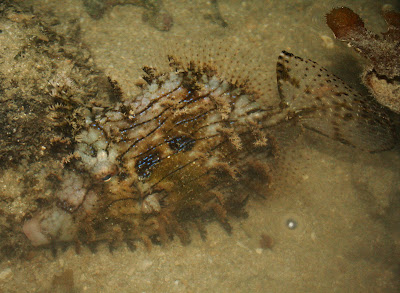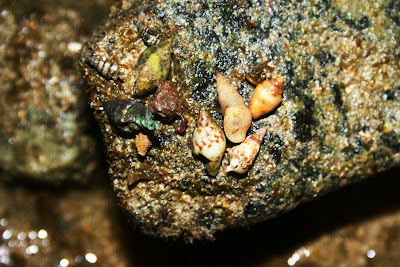
The trip to the Sister's Island has been really nice ;) Saw many of the intertidal critters I've not seen before, or rather hardly see (perhaps cos of my inexperience also), especially so for well camouflaged animals, so it requires so much of a sharp eye! It's really great to be back at the sea! Met a new friend, Erlina as well.
The Sisters' Islands are two actually two islands: the Big Sister and Small Sister. It legends has it said that these Sister Islands are as a result of a pair of drowned sisters. The two islands is separated by a narrow sea passageway- where the current is very strong, so it is not advised that we swim there.
Thanks to Ms Wang/Ron who organized this trip!
 We started out in the evening! It's a change from the early mornings that we've been Marina South Pier. It was pouring and pouring and pouring... But thank goodness, it was not raining as we reached the jetty.
We started out in the evening! It's a change from the early mornings that we've been Marina South Pier. It was pouring and pouring and pouring... But thank goodness, it was not raining as we reached the jetty.At the island :) The Big Sister! A beautiful and tranquil island, with Macaques as its primary residents.

The sand-sifting stars, is a new colony found at Sister's, according to R., who was really excited to see them! Apparently they were in the "mating position", as shown in the photo. There is no internal fertilization but being in this position increases frequency of fertilization. We saw so many of them.
 Black Sea Cucumber
Black Sea Cucumber
R. did mention that this is rather common at the Sister's. We found around three of these just within an approximate one-half metre square area.
 Limpets
Limpets
It's actually a snail, though it actually resembles barnacles. They secrete mucus as they move about to feed, then using it to trace back to their "homing scars". It was already fast approaching nightime, and these limpets were feeding on the available algae with its radula (it's teeth).
They spawn by the means of external fertilization, where eggs and sperms are released into the nearby water.
 Nerites
NeritesThere are so many on these stuck to the rocks at the shore area. No two of these patterns are alike!
#CAMOFLAGED ONE
M.Y. found this! It's an onchidium. It was really cute, cos we literally saw its small tentacles on the tip of its head. An onchidium is actually like a snail but without a shell. It's a sea slug.
Turban shell has a turban-like shape, and hence the name!
A variety of spiral melongella, gong gong and drills :-)
.jpg) Moon Snail 1 Natica zonalis (thanks SY for ID)
Moon Snail 1 Natica zonalis (thanks SY for ID)
This one's very very pretty! It's rarely spotted as well. It has a transparent patterned soft body while having a nice brown mantle. Moon snails have their names because their bodies can expand, much larger than their shell.
They are also fierce predators, where they can actually drill holes into the mantle/test of other shells..jpg) Moon Snail 2
Moon Snail 2
Moon snail number two, which is much more common, but still very pretty. I wonder, why do they actually not accumulate sediments on their shells like the rest of the other shells. Perhaps it's cos they're smooth.
.jpg) One of the most interesting finds of the day, the Land Hermit Crab. Hermit crabs move from houses as they grow larger, to make sure that they protect their soft bodies. This nice purple crab body is really pretty! They are decapods - have 10 legs and breathe through gills, and hence, these gills must remain most at all times.
One of the most interesting finds of the day, the Land Hermit Crab. Hermit crabs move from houses as they grow larger, to make sure that they protect their soft bodies. This nice purple crab body is really pretty! They are decapods - have 10 legs and breathe through gills, and hence, these gills must remain most at all times.
They still return to the sea to lay their eggs and are highly nocturnal.
In contrast, this is a sea-dwelling hermit crab. It has so much more hair!
#CAMOFLAGED TWO
Guess what this is?
 Yes! It's a spider conch, as you can see above. You can see its eyes. The spider conch is so well camouflaged in sediments such that it's so hard to spot!
Yes! It's a spider conch, as you can see above. You can see its eyes. The spider conch is so well camouflaged in sediments such that it's so hard to spot!
The spider conch can "jump" when it wants to. Red Egg Crab
Red Egg Crab
#CAMOFLAGED THREE
Goby
 Scorpion Fish
Scorpion Fish
Eel
 #CAMOFLAGED FOUR
#CAMOFLAGED FOURFilefish
 The big big carpet anemone!
The big big carpet anemone!Ball sponge - highly poisonous!
 Squid!
Squid!
Others:-
1 Octopus (spotted by quite a few)
- Easily squeezed its body into the crevices
2 Teddy Bear Crab (spotted by J.)
3 Water spider
4 Giant Carpet Anemone w Clownfish
Will type more another day :P Really tired. Anyw, got many sandfly bites! How how how )':




.jpg)



2 comments:
Hi, the tiger moon snail that you was talking abt is actualli not a tiger moon. Checked the ID from a molluscs expert, it is Natica zonalis~
ooooh, okay! thankew veli much. it does not have a common name?
Post a Comment